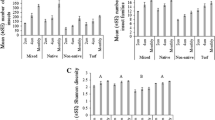Abstract
The analysis on nine inventories on the richness and diversity of galling herbivores in Brazil accounted for 806 gall systems occurring in 443 host-plant species from 74 plant families. This checklist of the Brazilian gall morphotypes proposes seven standardized morphotypes and five additional shapes that group the majority of the three-dimensional shapes reported in literature. Criteria are proposed to standardize the terminology, and a critical analysis is provided aiming to avoid possible inconsistencies in order to generate easily comparable data in future inventories. The morphotypes are herein catalogued in alphabetical order, accompanied by a conceptual definition, an illustration, and examples that best represent the shape. It is proposed that the inventories should present at least the (1) host-plant species, (2) galling herbivore species or its identification to the lowest possible taxonomic level, (3) host-plant galled organ and gall position, (4) gall morphotype, (5) gall color and registration of indumentum when present, (6) gall phenological and developmental data, (7) association with other trophic levels, and (8) additional information, such as dimension, and number of chamber(s).



Similar content being viewed by others
References
Abrahamson WG, Weis AE (1997) Evolutionary ecology across three trophic levels, Gondelrods, gallmakers, and natural enemies. Princeton University Press, New Jersey, p 456
Carneiro MAA, Borges RAX, Araújo APA, Fernandes GW (2009) Insetos indutores de galhas da porção sul da Cadeia do Espinhaço, MG, Brasil. Rev Bras Entomol 53(4):570–592
Costa FV, Fagundes M, Neves FS (2010) Arquitetura da planta e diversidade de galhas associadas a Copaifera langsdorffii (Fabaceae). Ecol Aust 20(1):9–17
Crawford DL (1925) Psyllidae of South America. Broteria (Série zoológica) 22:56–74
Dias GG, Moreira GRP, Ferreira BG, Isaias RMS (2013) Why do the galls induced by Calophya duvauae Scott on Schinus polygamus (Cav.) Cabrera (Anacardiaceae) change colors? Biochem Syst Ecol 48(2013):111–122
Espírito-Santo MM, Fernandes GW (2007) How many species of gall-inducing insects are there on earth, and where are they? Ann Entomol Soc Am 100(2):95–99
Gagné RJ, Oda RAM, Monteiro RF (2001) The gall midges (Diptera, Cecidomyiidae) of Mikania glomerata (Asteraceae) in Southeastern Brazil. Proc Entomol Wash 103(1):110–134
Gonçalves SJM, Moreira GRP, Isaias RMS (2009) A unique seasonal cycle in a leaf gall-inducing insect: the formation of stem galls for dormancy. J Nat Hist 43(13):843–854
Inbar M, Izhaki I, Koplovich A, Lupo I, Silanikove N, Glasser T, Gerchman Y, Perevolotsky A, Lev-Yadun S (2010) Why do many galls have conspicuous colors? A new hypothesis. Arthropod Plant Interact 4(1):1–6
Isaias RMS, Oliveira DC, Carneiro RGS (2011) Role of Euphalerus ostreoides (Hemiptera: Psylloidea) in manipulating leaflet ontogenesis of Lonchocarpus muehlbergianus (Fabaceae). Botany 89(9):581–592
Maia VC (2012) Characterization of insect galls, gall makers, and associated fauna of Platô Bacaba (Porto de Trombetas, Pará, Brazil). Bio Neotrop 11(4):1–17
Maia VC, Fernandes GW (2004) Insect galls from Serra de São José (Tiradentes, MG, Brazil). Braz J Biol 64(3):423–445
Maia VC, Oliveira KC (2010) Galhas de insetos da Reserva Biológica Estadual da Praia do Sul (Ilha Grande, Angra dos Reis, RJ). Bio Neotrop 10(4):227–238
Maia VC, Magenta MAG, Martins SE (2008) Ocorrência e caracterização de galhas de insetos em áreas de restinga de Bertioga (São Paulo, Brasil). Bio Neotrop 8(1):167–197
Malves K, Frieiro-Costa FA (2012) List of plants with galls induced by insects from the UNILAVRAS/Boqueirão Biological Reserve, Ingaí, state of Minas Gerais, Brazil. Check List 8(3): 426–431
Oliveira DC, Isaias RMS (2009) Influence of leaflet age in anatomy and possible adaptive values of the midrib gall of Copaifera langsdorffii (Fabaceae: Caesalpinioideae). Rev Biol Trop 57(1–2):293–302
Oliveira DC, Drummond MM, Moreira ASFP, Soares GLG, Isaias RMS (2008) Potencialidades morfogênicas de Copaifera langsdorffii Desf. (Fabaceae): super-hospedeira de herbívoros galhadores. Rev Biol Neotrop 5(1):31–39
Radford AE, Dickison WC, Massey JR, Bell CR (1974) Vascular plant systematics. Harper & Row, New York, 891 pp
Raman A (2007) Insect-induced plant galls of India: unresolved questions. Curr Sci 92(6):748–757
Santos JC, Almeida-Cortez JS, Fernandes GW (2011a) Diversity of gall-inducing insects in the high altitude wetland forests in Pernambuco. Northeast Brazil Braz J Biol 71(1):47–56
Santos JC, Almeida-Cortez JS, Fernandes GW (2011b) Richness of gall-inducing insects in the tropical dry forest (Caatinga) of Pernambuco. Rev Bras Entomol 55(1):45–54
Santos JC, Almeida-Cortez JS, Fernandes GW (2012) Gall-inducing insects from Atlantic forest of Pernambuco, Northeastern Brazil. Bio Neotrop 12(3):197–213
Valladares F, Sanchez-Gomez D, Zavala MA (2006) Quantitative estimation of phenotypic plasticity: bridging the gap between the evolutionary concept and its ecological. J Ecol 94(6):1103–1116
Veldtman R, McGeoch MA (2003) Gall-forming insect species richness along a non-scleromorphic vegetation rainfall gradient in South Africa: the importance of plant community composition. Aust Ecol 28(1):1–13
Acknowledgments
The authors thank FAPEMIG and CNPq for financial support and scholarships.
Author information
Authors and Affiliations
Corresponding author
Additional information
Edited by Kleber Del Claro – UFU
Rights and permissions
About this article
Cite this article
Isaias, R.M.S., Carneiro, R.G.S., Oliveira, D.C. et al. Illustrated and Annotated Checklist of Brazilian Gall Morphotypes. Neotrop Entomol 42, 230–239 (2013). https://doi.org/10.1007/s13744-013-0115-7
Received:
Accepted:
Published:
Issue Date:
DOI: https://doi.org/10.1007/s13744-013-0115-7




